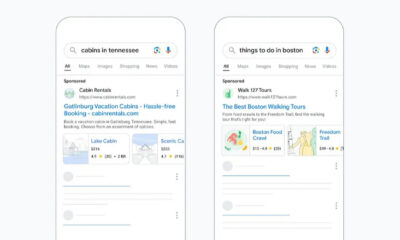PPC
Why You Can’t Afford to Ignore Responsive Display Ads

Despite being the default option when creating a new Display ad in Google Ads, advertisers are still reluctant to use Responsive Display Ads. However, like all things to do with Automation, our arms are gradually being twisted to accept them if we want to guarantee maximum performance in our accounts.
So what exactly are the benefits of using Responsive Display Ads, and why can’t advertisers afford to not be using them?
What are Responsive Display Ads?
To make sure we are all on the same page when it comes to Responsive Display Ads (RDAs), let’s briefly cover what they are and how they differ from standard Image Ads.
Source: Own account page screenshot of a preview of how an RDA can appear on a mobile device
Responsive Display Ads – Advertisers provide a range of different image and text assets, then Google automatically generates ad combinations, which adjust the size and appearance to fit available ad spaces.
Their key feature is that, unlike Image Ads, advertisers do not need to provide Google with a multiple-sized version of their Display Ads. Instead, by creating an RDA you are eligible for your ads to be used in an almost infinite amount of placements. This not only saves resources as you do not need to create a huge range of different-sized ads, but you can also add video assets. Google then decides which text, image, or video asset should be used, and how best to present them, based on the signals of the individual who will be seeing your ad.
Why You Should Be Using Responsive Display Ads
Whilst the time and resource-saving nature of RDAs is what appeals to most advertisers, a benefit which at times falls under the radar is strong Conversion Rates. Whilst utilizing RDAs is not guaranteed to improve the Conversion Rate of your Display campaigns, more and more advertisers are reporting on seeing it occur in their accounts.
Since running RDAs as ad options alongside Image Ads, I have seen much better performance from Display Campaigns.
Impression volumes have increased significantly, but more importantly, the Conversion Rate has improved. For one account, RDAs achieved a 0.37% Conversion Rate, compared to 0.12% for static Image Ads. Cost per Conversion was also 118.% lower for RDAs compared to Image Ads.
So why is this happening? Well, it’s a combination of things:
- Greater reach – With the RDAs being eligible to fit in any ad size available, advertisers are receiving a fast amount of opportunities for their ads to be used compared to their set-sized Image Ads. The more Impressions, the more opportunities for Clicks and therefore the more opportunities to generate a Conversion.
- Google prioritizes RDAs over Image Ads – Whilst there is no ‘official’ statement confirming this, countless real-life accounts argue that this is the case. If you don’t have an RDA option applicable to compete for a placement, then an advertiser with RDA variation is more likely to be chosen.
- Machine Learning Optimizations – Google’s Machine Learning will select the best ad combination in real-time, choosing an optimal mix of assets based on your performance history, asset content, and who your campaign is targeting. Simply put, no matter how amazing a PPCer you may be, you will never be able to apply such detailed optimizations for every single Impression your ads will receive.
Your Three Next Steps
So now you’re convinced that it’s time to include Responsive Display Ads in your PPC strategy, what should your next steps be?
1. Create RDAs to test against Image Ads
There’s no time like now to log into your account and get adding RDAs to your existing Display Campaigns. The RDA setup includes plenty of helpful guidance when it comes to creating your ad. Be sure to complete each field, and take note of the Ad Strength bar which includes pointers on what other assets you should add.

Source: Own account screenshot of the RDA setup page
2. Compare Ad Format performance
Once you’ve got an adequate amount of data, take a look at the difference in performance between your RDAs and Image Ads. By now you should be seeing an increase in your Impressions, as your RDAs open up new placement opportunities that Image Ads alone couldn’t fulfill.
3. Get your ticket to Hero Conf London
I’ll be discussing the do’s and don’ts of RDAs and what you can do to take performance to the next level at Hero Conf London in July. This will include what you can do to have as much control as possible on how your ads look, guidance for choosing your text assets, and best practices when selecting your images.
Final Thoughts
Whilst reporting data of RDAs is sparse, for example, you can not see the exact ad combination which generated a Conversion, the bottom line performance of RDAs is hard to resist. Simply adding an RDA to your existing Display campaigns can improve your campaign reach and performance, with minimal effort required post ad creation.

















You must be logged in to post a comment Login